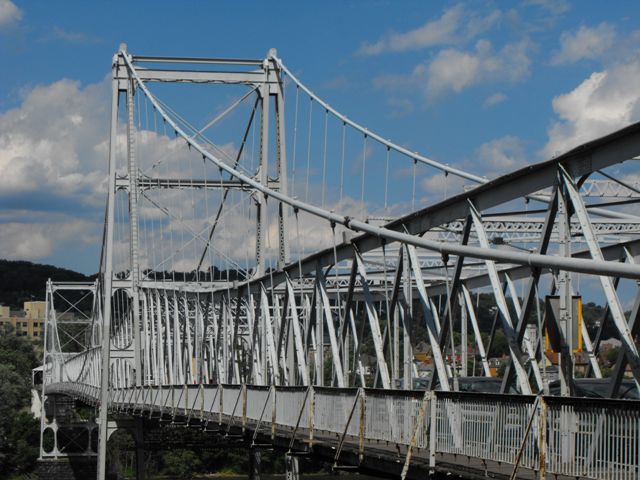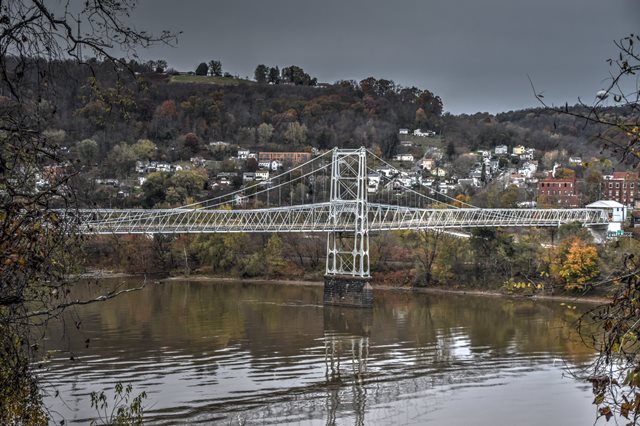We Recommend:
Bach Steel - Experts at historic truss bridge restoration.
Newell Bridge
Wayne Six Toll Bridge

Primary Photographer(s): Nathan Holth and Rick McOmber
Bridge Documented: July 12, 2009, May 29, 2018, and November 4, 2019
East Liverpool and Newell: Columbiana County, Ohio and Hancock County, West Virginia: United States
1905 By Builder/Contractor: American Bridge Company of New York, New York and Engineer/Design: Edwin Kirtland Morse of Pittsburgh, Pennsylvania
1954
742.0 Feet (226.2 Meters)
1,590.0 Feet (484.6 Meters)
20.7 Feet (6.31 Meters)
3 Main Span(s)
1502425

View Information About HSR Ratings
Bridge Documentation
View Archived National Bridge Inventory Report - Has Additional Details and Evaluation
This bridge is similar to the Market Street Bridge but the Newell Bridge retains a vastly higher degree of historic integrity, having no major alterations or loss of original material.
This bridge is an impressive cable suspension bridge with riveted Double-Intersection Warren through truss stiffening. The main cable is a wire cable, while the suspenders are steel rods with eyes and turnbuckles. The bridge has been noted as one of the first suspension bridges to have been built entirely of steel as opposed to wrought iron. This is not the result of anything spectacular, it is merely a function of its 1905 construction date. Prior to 1900 wrought iron was widely used for metal highway bridges because it was less expensive. During that time steel was also produced but was used for railroad rails where the stronger steel was a requirement, and this drove up the prices of steel, while wrought iron remained affordable. However, after 1900, steel became readily available and wrought iron quickly became a thing of the past.
The bridge's stiffening trusses have two styles of sway bracing that changes from every other panel. One is v-laced design whose height tapers at each end, and the other is made of two lightweight beams that also has attractive curved knee bracing curling above and below the lower beams, and below the upper beam. The merger of the upper beam's knee bracing and the upper knee brace of the lower sway bracing beam create a half-circle appearance. There is also a couple spots where there is a third built-up box beam acting as sway bracing.
The Newell Bridge is historically significant as one of the last few remaining suspension bridges on the Ohio River. There used to be many more, but they have been destroyed one way or another. It is also among the oldest bridges remaining on the Ohio River. The Ohio River has been devastated by the repeated frequent demolition of major historic bridges and so the surviving historic bridges on the Ohio River are becoming more and more critical to prioritize for preservation. The bridge is also significant because it documents the suspension bridge type as it was being used in the period very well, and as such is a good representative example of the technology.
The Newell Bridge is a privately owned toll bridge, that was owned by a company originally known as the Newell Bridge Company, then the Newell bridge and Railway Company, and today the Homer Laughlin China Company. The bridge has been extremely well maintained. Private bridge owners do what is most fiscally responsible for the profitability of their investment, and that is to properly maintain the bridge, and perform larger rehabilitation projects as needed. Private owners realize that ignoring routine maintenance and then demolishing and replacing the bridge is more costly. Government agencies should take note of this, since they often instead waste tax dollars by neglecting old and historic bridges until they deteriorate then they demolish and replace them.
The toll house on this bridge appears to have riveted roof trusses and as such it is certainly old and may be original along with the bridge.
The historic bridge inventory mentions that E. K. Morse of Pittsburgh was consulting engineer. This is assumed to be Edwin Kirtland Morse. He was an engineer for the Morse Bridge Company of Youngstown, Ohio who begin doing engineering consultation on his own in Pittsburgh after the Morse Bridge Company went out of business.
Information and Findings From Ohio's Historic Bridge InventorySetting/Context The toll bridge carries a 2-lane road and sidewalk
over the Ohio River between Newell, W.Va., and East Liverpool, Ohio. The
Homer Laughlin China factory complex is on the West Virginia end of the
bridge. The bridge's northern (Ohio) approach spans cross over the
4-lane US 30. Ohio DOT BMS inventories the two truss approach spans, and
WVDOT inventories the main suspension span over the river, but
historically they are all part of the same privately-owned toll bridge
structure. Physical Description The Newell Toll Bridge is a suspension bridge with a 750'-long main span flanked by steel truss approach spans. The cable suspension bridge has built-up steel towers and is conventionally composed of wrapped steel wire cables with wire suspenders and a stiffening truss. The stiffening truss is a riveted, double-intersection Warren configuration which transitions to simply supported thru-truss approach spans. Integrity The bridge appears to retain integrity of design and materials. Summary of Significance The Newell Toll Bridge is historically significant
for its associations with the development of the Homer Laughlin China
Company and the company town of Newell, W.Va. (Criterion A). The Newell
Bridge Company applied to the War Department for a permit to build over
navigable water and was awarded the permit in 1903. The permit was
modified in 1904 when the alignment of the bridge was shifted 75' north
from the original proposed alignment due to difficulty acquiring clear
title to the approach on the Ohio side. The bridge's design was by
consulting engineer E. K. Morse of Pittsburgh. Construction contracts
were awarded in May 1904 with the steel work awarded to the American
Bridge Company of Pittsburgh and the substructure work to Mr. C. M.
Driver, also of Pittsburgh. The eligibility of the Newell Toll Bridge has not been previously considered by either WVDOT or ODOT (Apr. 2009) (Communication with C. Fint, WVDOT). Justification The bridge is one of 10 suspension bridges inventory. The bridge type is used for both pedestrian and vehicular bridges starting with Roebling's 1856-67 Cincinnati bridge. This later example, representative of the type/design, has a moderate level of significance. Bridge Considered Historic By Survey: Yes |
This bridge is tagged with the following special condition(s): Unorganized Photos
![]()
Photo Galleries and Videos: Newell Bridge
Bridge Photo-Documentation
Original / Full Size PhotosA collection of overview and detail photos. This gallery offers photos in the highest available resolution and file size in a touch-friendly popup viewer.
Alternatively, Browse Without Using Viewer
![]()
Bridge Photo-Documentation
Mobile Optimized PhotosA collection of overview and detail photos. This gallery features data-friendly, fast-loading photos in a touch-friendly popup viewer.
Alternatively, Browse Without Using Viewer
![]()
2018-9 Additional Unorganized Photos
Original / Full Size PhotosA supplemental collection of photos that are from additional visit(s) to the bridge and have not been organized or captioned. This gallery offers photos in the highest available resolution and file size in a touch-friendly popup viewer.
Alternatively, Browse Without Using Viewer
![]()
2018-9 Additional Unorganized Photos
Mobile Optimized PhotosA supplemental collection of photos that are from additional visit(s) to the bridge and have not been organized or captioned. This gallery features data-friendly, fast-loading photos in a touch-friendly popup viewer.
Alternatively, Browse Without Using Viewer
![]()
Maps and Links: Newell Bridge
Coordinates (Latitude, Longitude):
Search For Additional Bridge Listings:
Bridgehunter.com: View listed bridges within 0.5 miles (0.8 kilometers) of this bridge.
Bridgehunter.com: View listed bridges within 10 miles (16 kilometers) of this bridge.
Additional Maps:
Google Streetview (If Available)
GeoHack (Additional Links and Coordinates)
Apple Maps (Via DuckDuckGo Search)
Apple Maps (Apple devices only)
Android: Open Location In Your Map or GPS App
Flickr Gallery (Find Nearby Photos)
Wikimedia Commons (Find Nearby Photos)
Directions Via Sygic For Android
Directions Via Sygic For iOS and Android Dolphin Browser
USGS National Map (United States Only)
Historical USGS Topo Maps (United States Only)
Historic Aerials (United States Only)
CalTopo Maps (United States Only)



